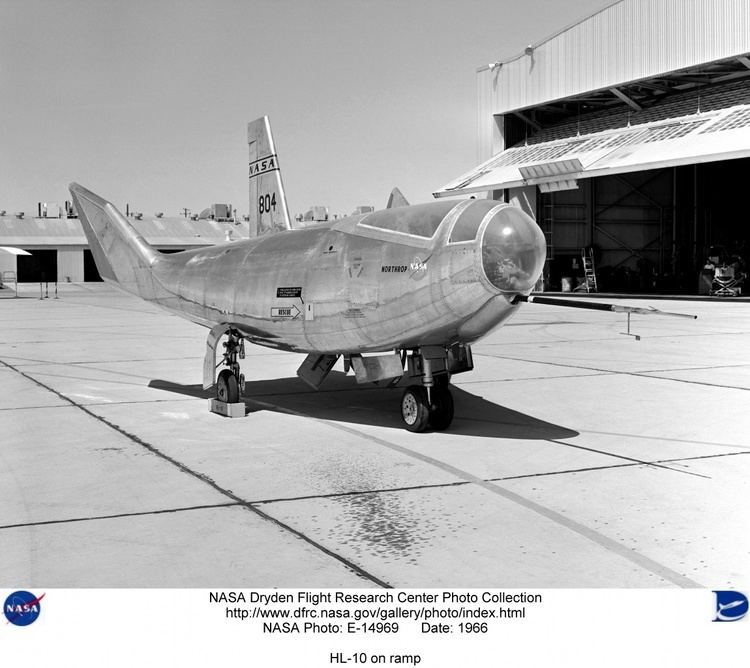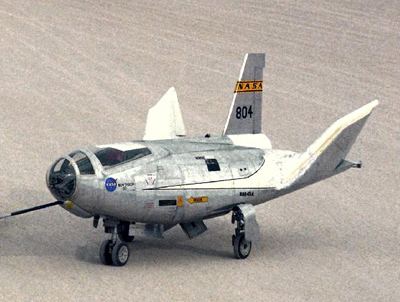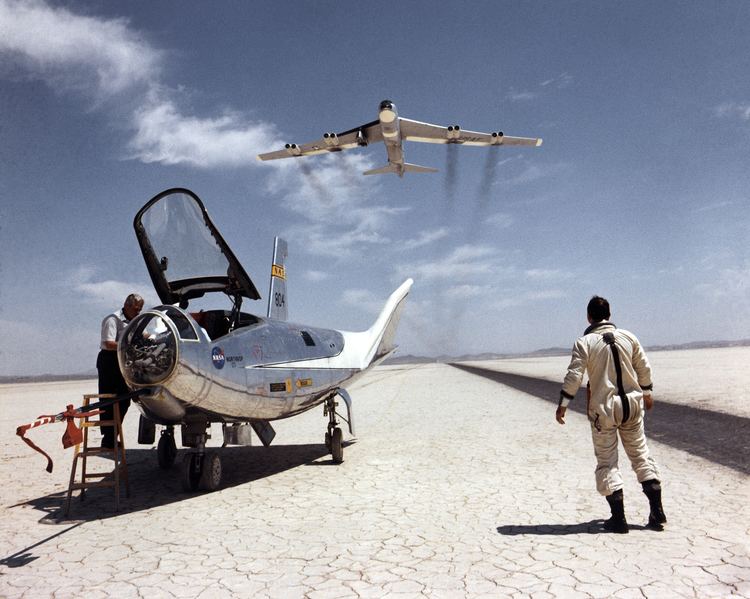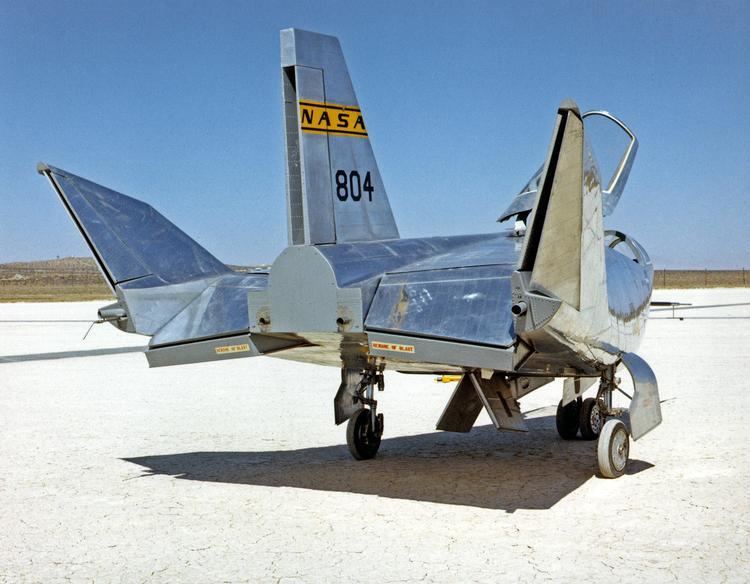Top speed 1,976 km/h Wingspan 4.15 m Weight 2,397 kg First flight December 22, 1966 | Range 72 km Length 6.45 m Engine type Reaction Motors XLR11 | |
 | ||
Northrop hl 10 m2 f2 lifting bodies promo film 1969
The Northrop HL-10 was one of five American heavyweight lifting body designs flown at NASA's Flight Research Center (FRC—later Dryden Flight Research Center) in Edwards, California, from July 1966 to November 1975 to study and validate the concept of safely maneuvering and landing a low lift-over-drag vehicle designed for reentry from space. It was a NASA design and was built to evaluate "inverted airfoil" lifting body and delta (letter) planform. It currently is on display at the entrance to the Dryden Flight Research Center at Edwards Air Force Base.
Contents
- Northrop hl 10 m2 f2 lifting bodies promo film 1969
- Development
- Operational history
- Unrealized space flight
- Aircraft serial number
- Status
- General characteristics
- Performance
- References

Development

Northrop Corporation built the HL-10 and Northrop M2-F2, the first two of the fleet of "heavy" lifting bodies flown by the NASA Flight Research Center. The contract for construction of the HL-10 and the M2-F2 was $1.8 million. "HL" stands for horizontal landing, and "10" refers to the tenth design studied by engineers at NASA's Langley Research Center, Hampton, Virginia. Main gear was a modified T-38 system retracted manually, and lowered by nitrogen pressure. Nose gear was modified T-39 unit, retracted manually and lowered with nitrogen pressure. Pilot Ejection System was a modified F-106 system. Silver zinc batteries provided electrical power for control system, flight instruments, radios, cockpit heat, and stability augmentation system. To assist in pre-landing flare, four throttleable hydrogen peroxide rockets provided up to 400 lbf (1.8 kN) of thrust.
Operational history

After delivery to NASA in January 1966, the HL-10 made its first flight on December 22, 1966, with research pilot Bruce Peterson in the cockpit. Although the XLR-11 rocket engine (same type used in the Bell X-1) was installed, the first 11 drops from the B-52 launch aircraft were unpowered glide flights to assess handling qualities, stability, and control. In the end, the HL-10 was judged to be the best handling of the three original heavy-weight lifting bodies (M2-F2/F3, HL-10, X-24A).

The HL-10 was flown 37 times during the lifting body research program and logged the highest altitude and fastest speed in the lifting body program. On February 18, 1970, Air Force test pilot Peter Hoag piloted the HL-10 to Mach 1.86 (1,228 mph). Nine days later, NASA pilot William H. "Bill" Dana flew the vehicle to 90,030 feet (27,440 m), which became the highest altitude reached in the program.

During a typical lifting body flight, the B-52—with the research vehicle attached to the pylon mount on the right wing between the fuselage and inboard engine pod—flew to a height of about 45,000 feet (14,000 m) and a launch speed of about 450 mph (720 km/h).

Moments after being dropped, the XLR-11 was lit by the pilot. Speed and altitude increased until the engine was shut down by choice or fuel exhaustion, depending upon the individual mission profile. The lifting bodies normally carried enough fuel for about 100 seconds of powered flight and routinely reached from 50,000 feet (15,000 m) to 80,000 feet (24,000 m) and speeds above Mach 1.
Following engine shutdown, the pilot maneuvered the vehicle through a simulated return-from-space corridor into a pre-planned approach for a landing on one of the lakebed runways on Rogers Dry Lake at Edwards. A circular approach was used to lose altitude during the landing phase. On the final approach leg, the pilot increased his rate of descent to build up energy. At about 100 feet (30 m) altitude, a "flare out" maneuver dropped air speed to about 200 mph (320 km/h) for the landing.
Unusual and valuable lessons were learned through the successful flight testing of the HL-10. During the early phases of the Space Shuttle development program, lifting bodies patterned on the HL-10 shape were one of three major types of proposals. These were later rejected as it proved difficult to fit cylindrical fuel tanks into the always-curving fuselage, and from then on most designs focused on more conventional delta wing craft.
Unrealized space flight
According to the book "Wingless Flight", by project engineer R. Dale Reed, if he had had his way, the HL-10 would have flown in space in the early to mid-1970s. Following the cancellation of the Apollo moon project, Reed realized that there would be substantial Apollo hardware left over, including several flight-rated command modules and Saturn V rockets.
His plan was to heavily modify the HL-10 at the Flight Research Center with the addition of an ablative heat shield, reaction controls, and other additional subsystems needed for manned spaceflight. The now space-rated vehicle would have then flown on the Apollo-Saturn V launch vehicle in the same space which originally held the Lunar Module.
Once in Earth orbit, it was planned that a robotic extraction arm would remove the vehicle from the rocket's third stage and place it adjacent to the manned Apollo CSM spacecraft. One of the astronauts, who would be trained to fly the vehicle, would then spacewalk from the Apollo and board the lifting body to perform a pre-reentry check on its systems.
It was planned that there would be two flights in this program. In the first, the lifting body pilot would return to the Apollo and send the HL-10 back to earth unmanned. If this flight was successful, on the next launch, he would then pilot the HL-10 back to earth for a planned landing at Edwards AFB.
Reportedly, Wernher von Braun thought it a wonderful idea and offered to prepare two Saturn Vs and Apollo Command Service Modules for the mission. Flight Research Center director Paul Bickle said no, stating that this was beyond his expertise or area of interest.
Aircraft serial number
Status
The HL-10 is currently on display at the entrance of Armstrong Flight Research Center at Edwards, CA.
